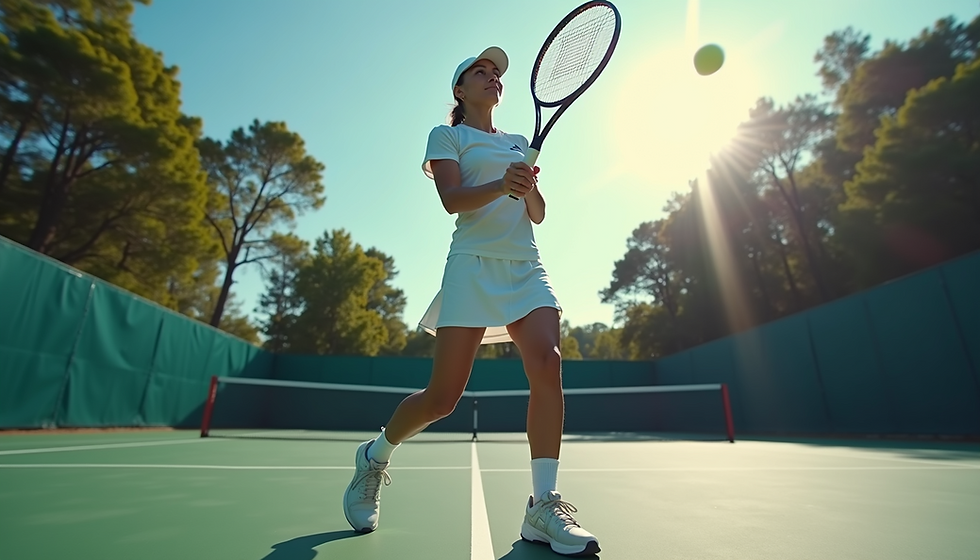Personalized Training Techniques for Tennis Success
- Tennis Theory
- Sep 29
- 4 min read
When it comes to tennis, no two players are exactly alike. Your strengths, weaknesses, body mechanics, and goals all differ. That’s why custom tennis training is essential for serious players who want to improve efficiently and avoid injuries. I’ve seen firsthand how tailored programs can unlock potential and transform performance. Let’s dive into how you can personalize your training to reach new heights on the court.
Why Custom Tennis Training Matters
Generic training plans can only take you so far. They often overlook your unique biomechanics, playing style, and physical condition. Custom tennis training focuses on your individual needs, helping you build on your strengths and address specific weaknesses.
For example, if you have a powerful forehand but struggle with footwork, your training will emphasize agility drills and balance exercises. If injury prevention is a priority, your program will include targeted strengthening and flexibility routines.
Personalized training also keeps you motivated. When you see progress tailored to your game, it’s easier to stay committed. Plus, it reduces the risk of overtraining or developing bad habits.

How to Build Your Custom Tennis Training Plan
Creating a personalized plan involves several key steps. Here’s a simple framework you can follow:
Assess Your Current Level and Goals
Start by evaluating your strengths, weaknesses, and fitness. What aspects of your game need improvement? Are you aiming to increase power, improve consistency, or prevent injuries? Clear goals will guide your training focus.
Analyze Your Biomechanics
Understanding how your body moves during strokes and footwork is crucial. This can be done through video analysis or working with a coach who specializes in biomechanics. Identifying inefficient movements helps prevent injury and improves technique.
Incorporate Specific Drills and Exercises
Tailor drills to your needs. For example, if your serve lacks speed, include exercises that build shoulder strength and explosive power. If endurance is an issue, add interval training and stamina-building workouts.
Schedule Recovery and Injury Prevention
Recovery is just as important as training. Include stretching, foam rolling, and rest days. If you have a history of injuries, add targeted strengthening exercises to support vulnerable areas.
Track Progress and Adjust
Regularly review your performance and adjust your plan accordingly. This keeps your training dynamic and responsive to your evolving needs.
By following these steps, you create a roadmap that’s tailored to your unique tennis journey.
What are the 5 Fundamentals of Tennis?
Mastering the basics is the foundation of any successful tennis training program. The five fundamentals are:
Grip
Your grip affects control and power. Whether you use an Eastern, Western, or Continental grip, it should feel comfortable and suit your playing style.
Stance and Footwork
Good footwork positions you to hit the ball effectively. Practice split steps, lateral movement, and quick direction changes.
Swing Technique
A smooth, consistent swing generates power and accuracy. Focus on proper backswing, contact point, and follow-through.
Serve
The serve starts every point. Work on toss consistency, body rotation, and explosive leg drive.
Mental Focus
Tennis is as much mental as physical. Develop concentration, resilience, and strategic thinking.
Focusing on these fundamentals during your custom tennis training ensures a solid base to build advanced skills.

Integrating Science-Backed Tennis Training Techniques
To maximize your results, incorporate science-backed methods into your routine. The Tennis Theory offers advanced biomechanical analysis and personalized development plans that can revolutionize your training.
For instance, using motion capture technology, you can identify subtle inefficiencies in your stroke mechanics. This data allows you to make precise adjustments that improve power and reduce injury risk.
Nutrition and recovery science also play a role. Tailoring your diet and rest periods to your training load helps maintain energy and promotes muscle repair.
If you want to explore more about effective tennis training techniques, I highly recommend checking out resources that combine expert coaching with scientific insights.

Practical Tips to Stay Consistent and Motivated
Consistency is key in any training program. Here are some tips to keep you on track:
Set Short-Term and Long-Term Goals
Break your ultimate goal into smaller milestones. Celebrate each achievement to stay motivated.
Mix Up Your Routine
Avoid boredom by varying drills, exercises, and practice formats. This also challenges your body in new ways.
Use Technology
Apps and wearable devices can track your progress and provide feedback.
Find a Training Partner or Coach
Accountability helps maintain discipline and provides valuable feedback.
Listen to Your Body
Don’t push through pain. Adjust your training to prevent injuries.
Remember, improvement takes time. Stay patient and trust the process.
Unlock Your Full Potential with Personalized Training
Custom tennis training is not just about working harder but working smarter. By focusing on your unique needs and leveraging science-backed methods, you can enhance your performance and enjoy the game more.
Whether you’re a junior player aiming to climb the ranks or a seasoned competitor looking to refine your skills, personalized training offers a clear path forward. Embrace the journey, stay committed, and watch your game transform.
Your best tennis is just around the corner. Keep pushing, stay focused, and let your personalized training plan guide you to success.




Comments